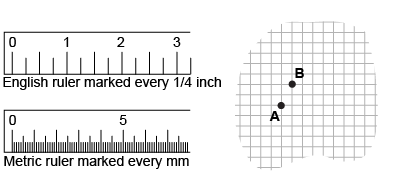- What is the difference between weight and mass? Provide an example in your answer.
- What is the difference between fundamental and derived units?
- List the following in order of increasing mass.
| a. two-bedroom house | | b. bouquet of flowers | | c. mosquito | | d. automobile | | e. computer mouse | | f. a bacterium |
- Which is longer, 1.23 mm or 2.34×105 μm?
- Would you use an electron microscope or a meter stick to make measurements at macroscopic scales?
- What metric unit of length is most useful for measuring the following lengths?
- height of a 5-year-old boy
- thickness of a piece of paper
- Diameter of a quarter
- Thickness of a dime
- Distance from New York, NY, to Sacramento, CA
- Josephine measured the masses of a textbook and feather and concluded that the feather had more mass. How could you check her result?
 A block of foam and a ball of clay both have the same mass. Which one occupies a larger volume? A block of foam and a ball of clay both have the same mass. Which one occupies a larger volume?
- In case of a fire or other emergency in the classroom laboratory or outdoors during a field investigation, should you text message your friends, call your parents, or inform the instructor?

- What is the length of this tuning fork as measured using this metric ruler?
- Describe at least three different causes of uncertainties in measured data.
- Noorjehan measured the width of her desk to be 88.7 cm and the length of the soccer field to be 3.0×102 ft. Which measurement was more precise? Which measurement was more accurate? Why?
| | 
- What is the difference between precision and accuracy? You may use the diagrams above in your explanation.
- Write a short essay that is a persuasive argument either for or against a new initiative to increase the amount of material that is recycled at your school. Indicate which additional materials could and could not be recycled in this new program. Research details about the costs and benefits of recycling to include in your essay.

- Which of the two tools pictured above would be best to measure the separation between points A and B on the graph above?
- When you use water from the tap, should you be cautious in how much you use because fresh water is a resource that should be conserved?
- How many decimal places are there in each of the following measurements? How many significant figures are there in each?
| a. 2.998 cm | | b. 31.2 kg | | c. 500 m | | d. 0.209 μm | | e. 0.00030 s | | |
- Before the first day of conducting investigations in a classroom laboratory, which three of the following items should you know the location of and know how to operate?
| a. fire extinguisher | | b. scientific calculator | | c. eye wash | | d. safety shower |
- Which of the following are benefits of recycling aluminum cans? Select all that apply.
a. Reusing it takes less energy than refining it from ore.
b. Recycled aluminum has been sterilized.
c. Recycling aluminum reduces refuse going into landfills.
d. Recycled aluminum can be more expensive
than aluminum that has never been used.
- Which apparatus is the best choice to measure mass: a spring scale, a triple beam balance, or a digital hanging scale?
|

